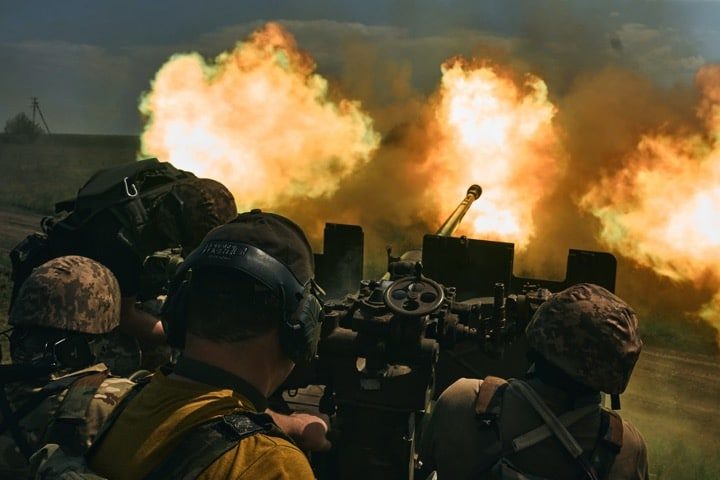
According to an ABC News report updated on June 9, Ukrainian armed forces have officially declared the start of an expected counteroffensive against Russian troops, with sources close to Ukrainian leader Volodymyr Zelensky alleging that Ukrainian forces were involved in face-offs with the Russian military.
Moreover, Ukraine’s Deputy Minister of Defense Hanna Maliar on June 6 made a short statement confirming that Ukraine was currently involved in “a defense-offensive operation.” This, she elaborated, encompassed “a spectrum of different actions, including offensive ones.”
Maliar highlighted that the battles were bloody, claiming that Russia’s forces were trying to halt the advance of Ukrainian forces. In response to questions about where Ukrainian soldiers had made advances, she indicated the Donetsk region on Ukraine’s eastern front.
The Washington Post reported fierce fighting in the Zaporizhzhia region, which the media outlet asserted was attributable to Ukraine’s tactic of isolating Russian forces from the Crimean Peninsula and decreasing Russia’s ability to resupply its forces in Ukraine.
The degree of progress that Ukrainian forces have made in the first phases of the counteroffensive remains uncertain. However, Ukraine reportedly has already mobilized Leopard II tanks, many of which were provided by NATO member states such as Germany, on the southeastern front.
Russia claims that Ukraine has already incurred significant losses in the initial days of the counteroffensive, maintaining that Kyiv has lost “more than 1,600 troops, 28 tanks, including 8 Leopard tanks and 3 AMX-10 wheeled tanks, 136 other military vehicles, including 79 foreign-manufactured ones.”
On its end, Ukraine says that Russia has lost at least 13 tanks and around 37 pieces of artillery. However, both warring countries failed to offer tangible proof of their claims of the destruction of military supplies.
Ukraine’s much-anticipated counteroffensive came after various noteworthy episodes in the Russo-Ukrainian conflict, such as the capture of the city of Bakhmut by Russian PMC Wagner Group mercenaries and the shelling of the Nova Kakhovka hydroelectric power plant earlier this week, which led to major flooding on the banks of the Dnipro River.
Kyiv declared that it was about to launch its counteroffensive on June 3, portrayed by some observers as a “D-Day” for the 21st century.
Speaking with The Wall Street Journal, Zelensky said in reference to the anticipated counteroffensive that “as of today, we are ready to do it. We would like to have certain things, but we can’t wait for months. We strongly believe we will succeed. I don’t know how long it will take.”
Keenly aware that a Ukrainian counteroffensive would ultimately happen, Moscow had been busy preparing for its own military retaliation, constructing an 800-kilometer defensive line including bunkers, trenches, and antitank ditches.
Commentators interviewed by The New York Times contend that the initial stage of Ukraine’s counteroffensive started on June 4, basing their analyses on satellite images. U.S. officials told the newspaper in the same report, published June 5, that, while Kyiv had not formally declared back then, by increasing their ground assaults and artillery attacks its forces demonstrated that their counteroffensive had begun.
Analysts quoted by the Times stated that military advancements in the eastern part of Ukraine would enable Kyiv to advance south toward the Sea of Azov and deprive the Russian mainland of Russia-controlled Crimea.
When questioned by the press on June 5 about whether the counteroffensive had begun, Pentagon spokesman John Kirby replied that the question was “for them [the Ukrainians] to speak to.” He added that the United States (Ukraine’s main supporter) was trying hard to “prepare them to be ready.”
Elaborating, Kirby said that whether Ukraine is “starting now or starting soon or whenever they decide to step off and whatever they decide to do, the President [Joe Biden] is confident that we did everything we could over the last six, eight months or more to make sure that they had all the equipment, the training, the capabilities to be successful.”
Russia’s Defense Ministry published a statement by Defense Minister Sergei Shoigu in which he claimed that Russian troops had impeded the first three days of a Ukrainian counteroffensive in which Kyiv had invested “large quantities of hardware and manpower.”
Shoigu lambasted Ukraine for shelling the Kakhovka dam on the Dnipro River, claiming it was a strategy to enable Kyiv to remobilize defensive units from the area downstream of the dam into offensive operations.
Previously, the Kremlin had denounced Kyiv for staging the attack to divert attention away from the failure of its offensive.
Ukraine accused Russia of shelling that partially ruined the Nova Kakhovka hydroelectric power plant on the Dnipro River in the southern Ukrainian Kherson oblast on June 6, CNN reported. After the alleged assault, Kyiv blamed Russia for “ecocide,” and instructed people in the area to “do everything you can to save your life.”
The Nova Kakhovka dam, which holds back around 18 cubic kilometers of water, is upstream from multiple villages and towns, including Kherson, which housed over 300,000 inhabitants before the outbreak of the conflict.
Kyiv claims that the Russians wanted to flood the area downstream from the dam to “create obstacles” for the counteroffensive of Ukrainian forces, insisting that Moscow does not consider the “catastrophic consequences” of its actions.
The destruction of the dam “only confirms for the whole world” that Russian forces “must be expelled from every corner of Ukrainian land,” Zelensky declared after an emergency meeting of security chiefs in Kyiv.
Russia, presently occupying the eastern bank of the river, denied responsibility for the attack and downplayed the gravity of the situation.
The Russian mayor of the occupied town of Nova Kakhovka stated that the attack on the dam was “a serious terrorist act,” but indicated that there was no necessity for evacuation.
“There is no threat to people’s lives,” another Russia-installed Kherson official stated, elaborating that water levels are being measured and everything is under control on the east bank. “If necessary, we are ready to evacuate the residents of embankment villages, buses are being prepared.”



